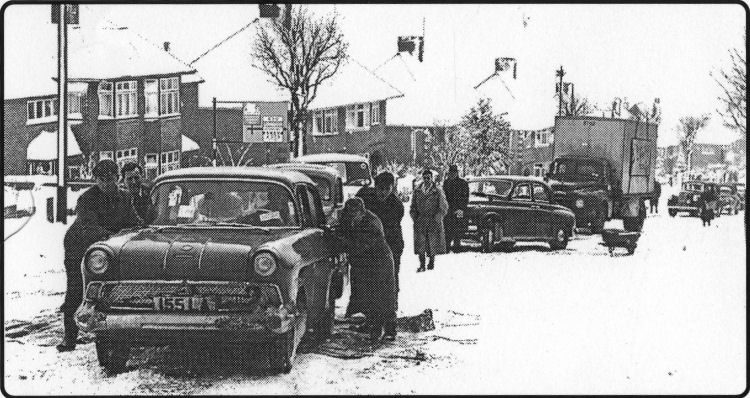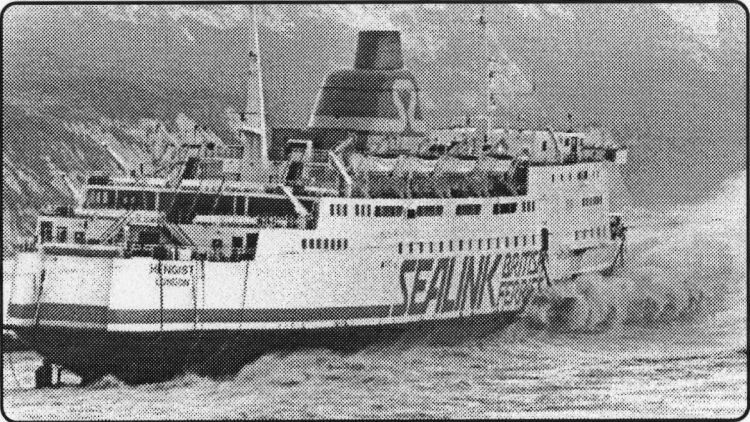
Published 7 December 2000
RECENT heavy rain and flooding add up to the most dramatic weather event
since the Hurricane of October 1987, known as the Great Storm.
That’s the opinion of Kent author Bob Ogley whose books have raised many
thousands of pounds for charity — nearly £100,000 in fact — since he went
into publishing with his classic weather book In The Wake of The Hurricane.
It sold almost 250,000 copies in various editions and projected him into the
best selling charts at his first attempt.
Now Bob Ogley, in conjunction with weather men Ian Currie and Mark Davison,
have produced an updated version of the Kent Weather Book, incorporating a
dramatic colour cover picture of flooding in Yalding in October caused by
the overflowing River Medway and other new pictures.
Vivid photographs inside the book include a period
painting of Walmer lifeboat being launched in the great storm of 1877 when a
tornado swept through Walmer, uprooting trees, damaging property and lifting
up a galley punt from the beach and dumping it in the sea.
Four years later it was the turn of Dover harbour where massive blocks
forming the parapet of the Admiralty Pier were toppled and strewn about like
children’s building bricks.
The large paperback book is well timed for the Christmas market and makes a
great coffee table book as well as a valuable work of reference. It is
priced at a modest £10.99.
Many interesting facts come out In the book which will make talking points
for years among families at home, in the ‘local,’ clubs and many other
places.
On a controversial note the author remains sceptical about the causes for
our undeniably peculiar weather in the year 2000.
He said he doesn’t necessarily agree about global warming. But it was a fact
that the Government and the Environment Agency had admitted for the first
time that there was a link between the devastating floods and climate
change.
“But that’s what they said after the great winter of 1947,” said Bob.
“When the snows finally melted experts predicted that we were entering the
new Ice Age." But he commented, it was 16 years before we had anything like
it again - with 1963 the coldest winter we have known.
“It is a fact that the weather in Kent has always been immensely variable,”
he says.
A fascinating feature is the great variety of supposed causes of bad
weather.
‘Experts’ blamed the terribly wet summer of 1917, during the First World
War, on the firing of guns on the battlefields of Flanders, says Bob.
Radio waves, space satellites, nuclear bomb blasts and even Concorde have
individually been blamed for causing atmospheric pollution that ‘changed’
the weather in the 30s, 40s, 50s and 60s.
Sadam Hussain supposedly triggered off the longest drought ever known when
he fired the oil wells during the Gulf War, as recently as 1991.
“Now we hear that global warming or climate change Is to blame for the
severity of millennium floods, as they are being called, when we ail know
that much of the liability lies with those local authorities in Kent who
have allowed new homes to be built on flood plains - reducing the amount of
storage capacity for water,” says Bob Ogley.
“The Environment Agency said that it objects to 30,000 applications a year
in areas prone to flooding, but 20 percent of these are approved, and
KATHARINE Marshall writes from St Leonards Road, Hythe, to which she moved
last year, to say she is very keen to learn something of the history of her
home, at No. 11. “It is in a terrace of six, and a neighbour told me this
dates from around 1840.
“Interestingly, she said that the terrace was built as a cottage hospital,
with the two three-storey houses acting as the hospital, and the four
two-storey houses providing nurse accommodation.”
But, says Miss Marshall, “I have not been able to find any information about
a hospital in St Leonard’s Road in the books and street directories I have
looked in, but am very keen to research this area.”
She has consulted Hythe Haven, by Duncan Forbes, and Kelly’s directories.
Can any reader help?
many are in Kent.
“Many are porches and conservatories, and are regarded as trivial by local
planners, but they still increase the area of building on a flood plain.
Surplus water is forced back into the river unnaturally fast, causing worst
flooding downstream,” Bob declared.
Many sources have been tapped by Bob for illustrations for his book,
including public libraries and museums, Kent’s local newspapers like the
Herald in Folkestone and Express at Dover - and you, the great British
public, who have responded magnificently and produced some historic gems as
a result of appeals in local newspapers for material for the book.
Other popular books written by Bob Ogley still in print include the
memorable four volumes of “Kent -A Chronicle of the Century, 1900-1999” and
“Kent at War,” each at £10.99 in paperback or £16.99 hardback. To follow is
a book on Kent ghosts!
Charity boost
Xr*!
FERRY Hengist swept onto the concrete apron at the Warren by the Hurricane
force winds which lashed the whole of Kent on October 16. 1987, causing
devastating damage. Hengist was later refloated.


 |
|
1900
Port cashes in on storm bound rival’s harbour.
«f QfWVTHE PORT was cashing in on bad weather which was preventing some
cross-Channel steamers entering Dover. Folkestone was enjoying a
mini-boom as goods traffic flooded in, particularly of meat, mainly pigs
and calves, probably destined for the Christmas market, and potatoes.
Local wine merchant Mr W.H. Lukey, who had six sons serving In the
regular or auxiliary armed forces, received a letter from tho Queen
expressing her admiration and the hope that his three sons serving in
South Africa would be “spared” and return home safely According to the
Folkestone Herald one of the most brilliant and successful balls in the
history of fashionable Folkestone was held at the Hotel Metropole a
century ago, arranged by a committee of officers chaired by Major
General Hallam Parr, but it sounds a rather 'posh' do. The Herald writer
noted that over 200 of the “elite of East Kent" attended, along with
others from much further afield. Creations of the top London and
Parisian dressmakers added glitter to the event while the midnight
dinner "was a triumph of the chef's art." said the report. Music camo
from the hotel's resident orchestra.
|
|
1925
Coal - burning Channel steamers switch to oil.
tf Cl'OW POPULAR Channel steamers Biarritz and JL&MmZr Maid of Orleans
were due to be converted from coal burners to oil-fired, the first named
having already left for Dumbarton for the conversion. A writer signing
himself “Queen’s Parker” called on more “public men” to support the
matches of Folkestone FC which, he said, deserved more public backing.
He paid tribute to what the club was doing with its limit resources.
Cherlton Road reader Albert Franks, ■shocked by the latest submarine
disaster, was calling for the scrapping of submarines in peace time and
a speed up iin the development of transport by air. The Folkestone
Fishermen's Institute was only £99 short in raising £700 for an
extension to Its dub rooms. There was a Foot & Mouth Disease scare In
the UK in 1925 and the Town Council published notices about Ministry of
Agriculture regulations. I noted with amusement and some sympathy a
Herald advertisement for typewriters which could “help those who
suffered writers’ cramp”! What a boon that Invention was, now being
eclipsed by all-powerful computers. Another advertisement reminds us of
the little Austin Seven car, briefly referred to last week, that could
motor 50 miles to the gallon of petrol and could carry up to 32 stone in
passengers and luggage, while road tax was only £8.
|
|
1950
The dawn of the‘super store’ as Co-op opens.
>4 Q rATHE TOWN'S first self-service store ±3vUwas expected to be opened
by the Cooperative Society in time for Christmas. It was planned for the
corner of Guildhall Street and Coolinge Road. There was heavy rain in
the district 50 years ago this week and many areas had flooded roads.
The Herald front page featured a picture of a Mark IX Spitfire fighter
aircraft which was due to go on 'permanent' display at Hawkinge airfield
from which some of the gallant “Few” had flown in the Battle of Britain.
Fifty years ago, as today, things were not as they should be on the
railways. A diesel-electric train locomotive was undergoing trials at
Folkestone. It was one of three, each of 1200 hp and weighing 120 tons,
built at the former Ashford Railway Works, which employed many local
people. Some 180 cars taking part in the annual Monte Carlo Rally were
expected in Folkestone in the New Year, arriving around 4am with two
hours to spare before their ferry sailed, and councillors were
considering ways to 'cash in' on this, possibly by offering breakfast
and hot baths. The French cargo ship Tildo, carrying oil to Antwerp, was
pictured aground at Jury’s Gap, in dense fog. with a recovery tug
standing by. But the vessel refloated safelv the following dav.
|
|
1975
Nearly 200 factory jobs going as Christmas nears.
ii| Q"/!! THERE was some gloomy news leading up JmSJ / 3 to Christmas in
Shepway 25 years ago. The Portex factory was set to lay off another 180
workers in the New Year, mostly part-timers, having already cut over 80
part-time jobs back in January and 24 full time and part-time workers
lator. Cutbacks were blamed on the ‘economic climate' of the time. At
the same time came news of possible Council House rent increases and a
rate rise. One bright feature, wrote the editor, were the Christmas
street decorations, particularly in Cheriton. Stalling Minnis parish
council took over responsibility for day-to-day running of the village
windmill and was all set to appoint a custodian and throw it open to the
public. A new call for the re-introduction of the death penalty was
backed by MP Albert Costain who had been advocating it for 10 years.
Workers of New Romney and Romney Marsh branch of the RNLI reflected on
an epic rescue involving lifeboat coxswain Ben Tart and crewman Peter
Thomas, who both earned bravery medals, at their annual meeting.
Battered by 100 mph hurricane force winds which spun the lifeboat around
like a top, the rescuers took an Injured seaman off the cargo boat Merc
Texco and then had to shield the leg fracture victim with their bodies
to prevent his being thrown about in the stormy seas during a six mile
journey to safety. |
|



